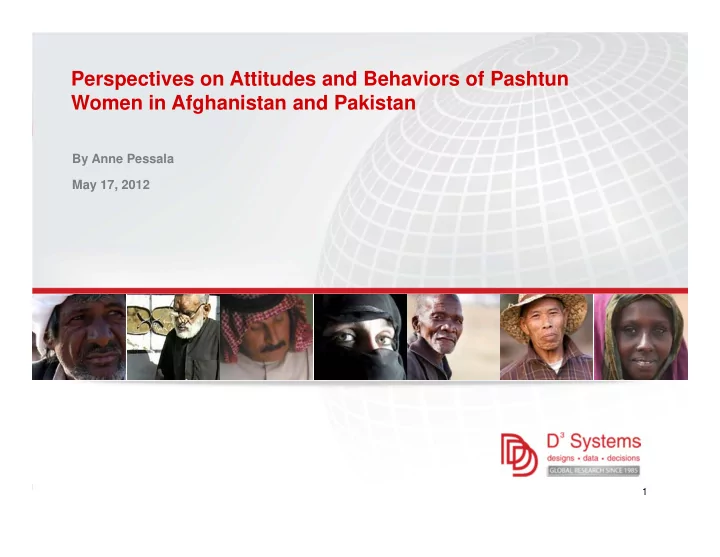

Perspectives on Attitudes and Behaviors of Pashtun Women in Afghanistan and Pakistan By Anne Pessala May 17, 2012 8000 Towers Crescent Dr. Suite 1350 Vienna, Virginia 22182 USA Ph.703.255.0884 Fx.703.255.6465 www.D3systems.com . . . . 1
Perspectives on Attitudes and Behaviors of Pashtun Women in Afghanistan and Pakistan • Who are the Pashtun people? • Methodology • Access to healthcare and education • Attitudes towards women’s rights • Finances • Voting behavior • Media behavior • Future research 2
Who are the Pashtun People? • Largest populations are in Pakistan (approx. 21 million) and Afghanistan (approx. 10 million) • Distinguished by language (Pashto) and adherence to Pashtunwali • Many principles of Pashtunwali direct the treatment and behavior of women • Rural population 3
Geographic Distribution of Pashtun Population Afghanistan Pakistan 4
What traits do Pashtuns share? • Per capita GDP in Afghanistan is $501 and $1,019 in Pakistan • Slightly higher incomes relative to general population • Role in government • Security 5
About the studies • 2007 – Afghanistan: 2,346 randomly selected Afghans in 34 provinces from March 7 th -14 th , 2007 (502 Pashtun women) – Pakistan: 2,065 randomly selected Pakistanis in four provinces from March 17 th -March 30 th (102 Pashtun women) • 2012 – Afghanistan: 2,018 randomly selected Afghans in 34 provinces from January 24 th -February 3 rd , 2012 (383 Pashtun women) – Pakistan: 2,065 randomly selected Pakistanis in four provinces from March 19 th -March 30 th (133 Pashtun women) 6
Access to Healthcare and 7 Education
Access to Healthcare • Afghanistan: – 1,400 maternal deaths out of every 100,000 live births – 14% of births attended by a trained medical professional • Pakistan: – 260 maternal deaths out of every 100,000 live births – 39% of births attended by a trained medical professional Source: World Statistics 2011 (World Health Organization) 8
Access to Healthcare Afghan Pashtun Women (APW) n=383 Pakistani Pashtun Women (PPW) n=133 Afghan Non-Pashtun Women (ANPW) n=603 Pakistani Non-Pashtun Women (PNPW) n=828 9
Education 2012 Average Years of Education % Illiterate 78% 77% 69% 61% 37% 36% 33% 17% 2007 2012 Afghanistan Pashtun Afghanistan Non-Pashtun Pakistan Pashtun Pakistan Non-Pashtun 2007 Afghan Pashtun Women n=502 Pakistani Pashtun Women n=102 2007 Afghan Non-Pashtun Women n=673 Pakistani Non-Pashtun Women n=858 2012 Afghan Pashtun Women (APW) n=383 Pakistani Pashtun Women (PPW) n=133 2012 Afghan Non-Pashtun Women (ANPW) n=603 Pakistani Non-Pashtun Women (PNPW) n=828 10
11 Attitudes Toward Women’s Rights
Attitudes towards women’s rights Do you believe that your country is closing the gap in inequality between men and women? 2012 Afghan Pashtun Women (APW) n=383 Pakistani Pashtun Women (PPW) n=133 Afghan Non-Pashtun Women (ANPW) n=603 Pakistani Non-Pashtun Women (PNPW) n=828 12
Attitudes towards women’s rights Do you agree that you personally are entitled to the same rights as men in this country? 2012 78% 77% 62% 56% 42% 36% 21% 19% 3% 2% 2% 2% Agree Disagree Ref./DK Pakistan Pashtun Pakistan Non-Pashtun Afghanistan Pashtun Afghanistan Non-Pashtun Afghan Pashtun Women (APW) n=383 Pakistani Pashtun Women (PPW) n=133 Afghan Non-Pashtun Women (ANPW) n=603 Pakistani Non-Pashtun Women (PNPW) n=828 13
14 Household Finance
Employment What is your job status now? 2012 Afghan Pashtun Women (APW) n=383 Pakistani Pashtun Women (PPW) n=133 Afghan Non-Pashtun Women (ANPW n=603 Pakistani Non-Pashtun Women (PNPW) n=828 15
Finance Who in your household decides what purchases are made to meet daily household needs like food, clothing and cleaning supplies? (Pashtun women only) 58% 50% 39% 34% 30% 24% 23% 23% 22% 19% 18% 17% 11% 10% 10% 9% 3% 2% Self Joint Spouse Other Ref./DK 2007 Afghanistan 2007 Pakistan 2012 Afghanistan 2012 Pakistan 2007 Afghan Pashtun Women n=502 Pakistani Pashtun Women n=102 2007 Afghan Non-Pashtun Women n=673 Pakistani Non-Pashtun Women n=858 2012 Afghan Pashtun Women (APW) n=383 Pakistani Pashtun Women (PPW) n=133 2012 Afghan Non-Pashtun Women (ANPW) n=603 Pakistani Non-Pashtun Women (PNPW) n=828 16
17 Voting
Voting behavior Did you vote in the last national election or referendum? 62% 61% 55% 58% 49% 44% 38% 28% 2007 2012 Afghanistan Pashtun Afghanistan Non-Pashtun Pakistan Pashtun Pakistan Non-Pashtun 2007 Afghan Pashtun Women n=502 Pakistani Pashtun Women n=102 2007 Afghan Non-Pashtun Women n=673 Pakistani Non-Pashtun Women n=858 2012 Afghan Pashtun Women (APW) n=383 Pakistani Pashtun Women (PPW) n=133 2012 Afghan Non-Pashtun Women (ANPW) n=603 Pakistani Non-Pashtun Women (PNPW) n=828 18
19 Media Behavior
Media Behavior Which source do you rely on most for news? 2012 88% 79% 50% 37% 35% 20% 19% 17% 15% 5% 4% 4% 3% 3% 3% 3% 3% 2% 1% 1% 1% 0% 0% Television Radio Friends or Family Newspaper/Magazine Mosque/Religious Don't Follow News Members Leader (vol.) Afghanistan Pashtun Afghanistan Non-Pashtun Pakistan Pashtun Pakistan Non-Pashtun Afghan Pashtun Women (APW) n=383 Pakistani Pashtun Women (PPW) n=133 Afghan Non-Pashtun Women (ANPW)n=603 Pakistani Non-Pashtun Women (PNPW) n=828 20
Summary • Pashtun women in both countries feel they have inferior access to services and fewer rights than men, although they are also more likely than non-Pashtun women to say they are entitled to fewer rights. • Pakistani Pashtun women’s access to health and education relative to non-Pashtun women is higher. • Limited access to education persists among Afghan Pashtun women, although the trend could change with the rising generation of girls who reached school age after the fall of the Taliban. 21
Future Research • Do Pashtun women in homogenous communities have greater influence and freedom of movement? • Television viewing • How will attitudes about women’s rights be affected by the transition in Afghanistan? 22
For More Information Regarding The Findings Provided In This Report Contact: D3 Systems 703.388.2450 Matthew Warshaw Vice President Matthew.Warshaw@d3systems.com Anne Pessala Research Analyst Anne.Pessala@d3ystems.com www.D3Systems.com 23
24
Recommend
More recommend